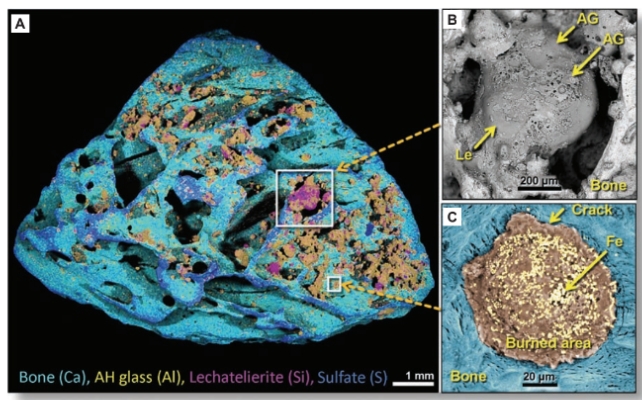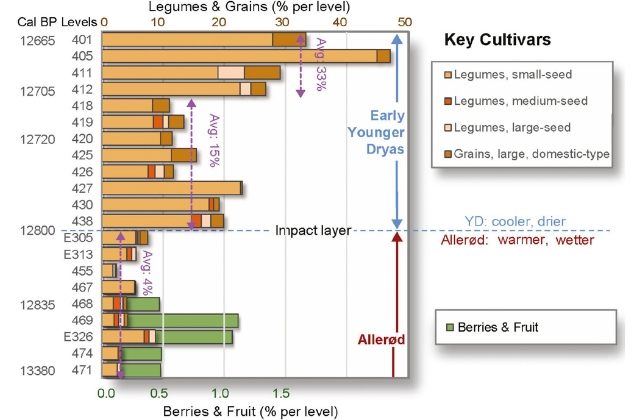Imagine being a hunter-gatherer nearly 13 thousand years ago. You're minding your own business – gathering berries and hunting wild animals – when suddenly a giant ball of fire appears in the sky.
It explodes with a deafening roar, sending shockwaves towards the ground and flattening trees and homes.
New research suggests this is how the first seeds of agriculture were planted in Syria, a necessary adaptation to improve the community's chances of survival.
After a comet's fragments slammed into Earth's atmosphere, the climate changed dramatically, with the plants and animals they relied on disappearing.
A global team presented their case after analyzing sediment layers from Neolithic site Abu Hureyra, which was excavated in the 1970s before being submerged under Lake Assad by the construction of the Euphrates dam. Abu Hureyra is well-known as the site with the earliest evidence of a shift from hunter-gathering to farming.
The group contributed four peer-reviewed papers to the study of the Younger Dryas impact hypothesis. This substantially disputed hypothesis proposes that a cosmic impact caused the Younger Dryas (YD) period – a rather sudden, severe, and lengthy interruption to the warming of Earth's climate.
"We present substantial new quantitative evidence and interpretations supporting the hypothesis that comet fragments triggered near-global shifts in climate ~12,800 years ago, and one airburst destroyed the Abu Hureyra village," the authors write.
The sediment layers revealed many factors, including types of plants collected in warmer, humid days before the YD climate change and in the colder, drier days after.
"These data include changes in building architecture, diet, the early stages of persistent cultivation of domestic-type grains and legumes," the team adds, "and the initial penning of livestock, marking the beginning of sustained agriculture and animal domestication."
Archeologist Andrew Moore from the Rochester Institute of Technology and team's comprehensive analysis also identified shock-fractured quartz grains, which are consistent with impact, and evidence of a massive firestorm.
"Shocked quartz is well known and is probably the most robust proxy for a cosmic impact," says Earth scientist James Kennett of the University of California Santa Barbara.
"In the papers, we characterize what the morphologies are of these shock fractures in these lower-pressure events."
Their initial study confirmed low-shock fractures in the quartz rocks at Meteor Crater, created by the Barringer meteorite impact.
Importantly, similar fractures occur in quartz exposed to nuclear explosions in the air, even if no impact crater forms. This has big implications, suggesting an asteroid or comet breaking apart close enough to Earth's surface could also cause these fractures via shockwaves across the world.
"For the first time," adds Kennett, "we propose that shock metamorphism in quartz grains exposed to an atomic detonation is essentially the same as during a low-altitude, lower-pressure cosmic airburst."
The second study is the first to identify shock-fractured quartz in the Abu Hureyra sediment layer from the boundary (the beginning) of the YD period. Detailed analysis showed some quartz grains in this layer are similar to those found in nuclear explosions and Meteor Crater.
"We wanted to compare it with what we have in the shock-fractured quartz in the YD boundary," Kennett says, "to see if there was any comparison or similarities between what we see at the Trinity atomic test site and other atomic bomb explosions."
Most of these quartz grains have been exposed to temperatures at least 1713 °C (3115 °F), which is the melting point of quartz, and most likely even higher than its boiling point of 2200 °C.
Extremely high temperatures and pressures lead to fracturing and melting of quartz grains and introduction of molten silica into fractures. When this non-crystalline silica is found in fractured rocks, it's a clear sign of an impact, as opposed to slow tectonic movement.
The third study found tiny diamonds, special crystals, and small balls made of silica and iron in the YD boundary layer sediment. Some of these substances could only have formed under higher temperature or pressure conditions than any human technology could produce at the time.

One substance, tiny spherules called meltglass, makes up about 1.6 percent of the sediment and was discovered on tools, bones, and clay walls, suggesting the impact really disrupted life in the village. Pieces of meltglass even have detailed imprints of plants.
Notably, the team didn't find similar material in thousands of years of human-deposited sediment above the YD boundary layer.
The final study presents new evidence of a direct connection between cosmic impacts, environmental shifts, and major changes in human societies.
"Our investigation reveals slow changes in site utilization by humans for centuries up until and just after the YD onset," the authors write, "punctuated by a significant, abrupt change immediately at the YD onset."
The team propose the changes came from a disintegrating large comet about 100 kilometers wide. This event likely set off major climate change in the northern hemisphere.

"There was a change from more humid conditions that were forested and with diverse sources of food for hunter-gatherers, to drier, cooler conditions when they could no longer subsist only as hunter-gatherers," says Kennett.
"The villagers started to cultivate barley, wheat and legumes. This is what the evidence clearly shows."
There's no doubt that something completely transformed the way people in Abu Hureyra lived.
"This change was a vital initial step in transitioning from exclusive hunting-gathering to sustained agriculture and herding," the authors conclude.
The studies have been published in Science Open: Airbursts and Cratering Impacts: here, here, here, and here.
